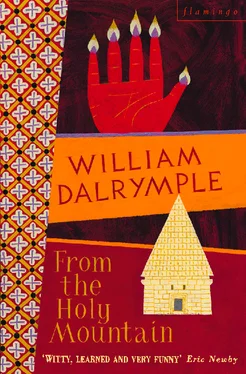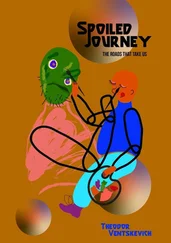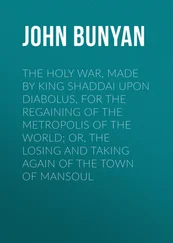‘Her mind is dead,’ said Fesih.
‘We look after her now,’ said his brother, returning with three glasses of tea. ‘We give her food and whatever else she needs.’
‘What about her family?’
‘They are all dead.’
‘And other Armenians?’
‘There are none,’ said Fesih. ‘There used to be thousands of them. Even when I was small there were very many. I remember them streaming out of here every Sunday, led by their priest. But not now. She is the last.’
We talked for twenty minutes, but Fesih would not let me stay to finish my tea.
‘You must go now,’ he said firmly. ‘It is not good to be on the streets of Diyarbakir after nightfall. It’s getting dark. You must hurry. Go now.’
Seeing what had happened in the last few months to the Armenian churches of Edessa and Diyarbakir – one in the process of being converted into a mosque, the other collapsing into a state of roofless ruination – reminded me of my first encounter with the increasingly rapid disappearance of Turkey’s Armenian heritage.
In the summer of 1987, a year after following Marco Polo’s route from Jerusalem to Xanadu, I returned to eastern Turkey to fill out my notes on the region, before setting about writing a book on the journey. The previous year I had spent a happy afternoon in Sivas, admiring the old Seljuk colleges there, and had noticed that in front of the Shifaye Medresse there lay a most unusual graveyard where tombstones inscribed in Ottoman Turkish, Armenian and Greek were all jostled together side by side.
On reflection I decided it must actually have been a lapidarium, or sculpture garden, rather than an ecumenical graveyard, for at no period have Muslims and Christians ever been buried side by side. But whatever it was, when I returned the following year the Armenian stones had all disappeared. The removal of perhaps fifteen heavy slabs and memorials would have been a considerable operation, and it had clearly taken place very recently, for the grass was still depressed and discoloured where they had rested; but when I asked the custodian where they had gone, he resolutely denied that any such stones had ever existed. I could probably have persuaded myself that I was mistaken and that the stones were my own invention, had I not actually written quite full descriptions of them in my notebooks the previous year. It was all very strange.
A week later I left Sivas and went to see a cousin who was working as an agricultural engineer in Erzerum, attempting to reintroduce silk farming to the region. Over dinner one night I happened to mention what I had seen, whereupon my cousin said that he had had a similar experience himself only the previous month. He told me that for four years he had been in the habit of taking an annual fishing holiday in the village of Maydanlar in the hills to the north of Tortum. On previous occasions he had admired a magnificent collection of early medieval Armenian cross-stones (known as khatchkars) which lay piled up near the village well; but this year the stones had all vanished. When he asked the villagers what had happened to them they became visibly nervous and would not tell him; it was only when he was alone with one old man that he learned what he believed to be the real story. Government officials from Erzerum had come through the village the previous month; they had asked the villagers for the whereabouts of any Armenian antiquities, and then proceeded to smash the stones up. Afterwards they had carefully removed the rubble.
I had heard other similar stories of the mysterious disappearance of Armenian remains, and the following year, working as a journalist on the Independent , I was able to investigate the subject in some detail. The trail led from the Armenian community in Paris, through Anatolia, to the library of the Armenian community in Jerusalem. By the end I had amassed a body of evidence which showed the alarming speed at which the beautiful, ancient and architecturally important Armenian churches of Anatolia were simply vanishing from the face of the earth.
An incomplete inventory of actively used Armenian churches compiled by the Armenian Patriarchate of Constantinople in 1914, immediately before the genocide, recorded 210 Armenian monasteries, seven hundred monastic churches and 1,639 parish churches, a total of 2,549 ecclesiastical buildings. A 1974 survey of the 913 buildings whose locations were still known found that 464 had completely disappeared, 252 were in ruins and only 197 remained in any sort of sound condition. Since then there had been several new discoveries, but the condition of most of the others had continued to deteriorate dramatically. Many still standing in 1974 had begun to crumble, while some extremely beautiful buildings had collapsed and completely disappeared.
There was nothing very sinister in the cause of the condition of many of the buildings. Some had been damaged by earthquakes; and the explosion of Turkey’s population had caused a demand for building materials which the churches readily supplied; others had been fatally undermined by Turkish peasants digging for ‘Armenian gold’, the legendary El Dorado of riches supposedly buried by the Armenians before they were ‘deported’ in 1915.
Nevertheless it was clear that the Turkish antiquity authorities had not exactly gone out of their way to stop the Armenian monuments from falling into decay. During the 1980s numerous Seljuk and Ottoman mosques and caravanserais had been restored and consolidated, but this treatment had not been extended to one single Armenian church. The Armenian monastery on the island of Aghtamar in Lake Van, arguably the most famous monument in eastern Anatolia, had belatedly been given a guardian, but this had not stopped the building’s decay: five of the main sculptures – including the famous image of Adam and Eve – had been defaced since the guardian’s appointment, and there had been no attempt to consolidate the building in any way. One British architectural historian I talked to maintained that there was a ‘systematic bias’ in what the Turks restored or preserved.
Moreover it was clear that academics – both Turkish and foreign – were strongly discouraged from working on Armenian archaeological sites or writing Armenian history. A British archaeologist (who, like almost everyone I talked to on this subject, begged to remain nameless) told me, ‘It is simply not possible to work on the Armenians. Officially they do not exist and have never done so. If you try to get permission to dig an Armenian site it will be withheld, and if you go ahead without permission you will be prosecuted.’ The truth of this was graphically illustrated in 1975 when the distinguished French art historian J.M. Thierry was arrested while making a plan of an Armenian church near Van. He was taken to police headquarters where he was fiercely interrogated for three days and three nights. He was released on bail and managed to escape the country. In his absence he was sentenced to three months’ hard labour.
Fear of this sort of thing severely restricts the investigation of Armenian remains and leads to a kind of selective blindness in those scholars whose professional careers demand that they continue to work in Turkey. In 1965 plans were announced for the building of a huge hydro-electric scheme centred on the Keban dam, near Elazig in the south-east of the country. The artificial lake this created threatened a number of important monuments, and a team of international scholars co-operated in the rescue operation.
Five buildings were of particular importance: a pair of fine Ottoman mosques, a small Syrian Orthodox church, and two Armenian churches, one of which contained exceptional tenth-century frescoes. The rescue operation is recorded in the Middle East Technical University (Ankara) Keban Project Proceedings . The report describes how the two mosques were moved stone by stone to a new site. The Syrian Orthodox church was surveyed and excavated. The two Armenian churches were completely ignored. Although the most ancient and perhaps the most interesting of the threatened monuments, they did not even receive a mention in the report. They now lie for ever submerged beneath the waters of the lake.
Читать дальше












